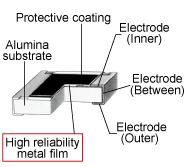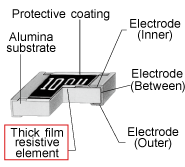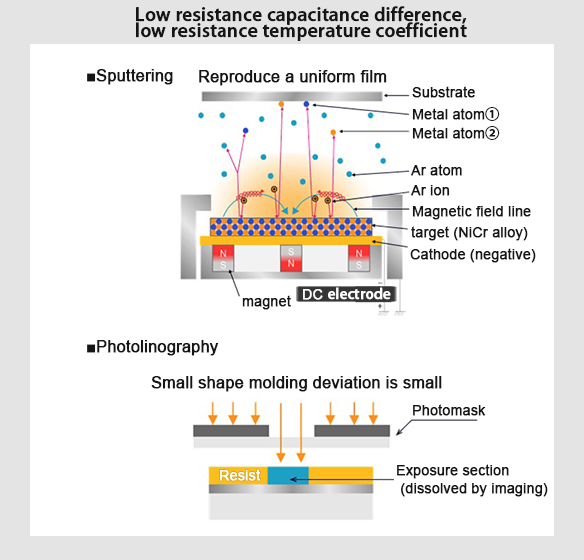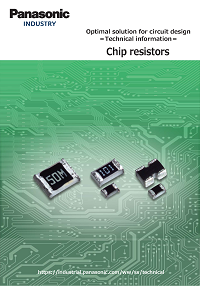High Precision Chip Resistors that Promote High Performance, Safety Improvement, and Energy Saving
2018-02-05
Our Technical Information No. 6 introduced current sensing chip resistors. We will introduce high precision chip resistors in this issue.
What are high precision chip resistors?
There are no strict definitions or types of high precision chip resistors. However, they usually refer to resistors with high-precision resistances (Tolerance) and small temperature coefficients (TCR). They are sometimes referred to as precision resistors. The initial precision of resistors can be set high through the adjustment processes during manufacturing. However, because resistances fluctuate in accordance with environmental conditions such as temperatures, they need to have small temperature coefficients, as well as the ability to maintain stable precision against temperature fluctuations.
Applications of High Precision Resistors
High precision resistors are required when carrying out high precision measurements and controls that make use of the high precision of these resistors. For example, the output voltage VOUT of the inverting amplifier of the operational amplifier shown below is determined by the equation indicated. It's the same for the voltage regulator VOUT. As shown by the equations, if the operational amplifier and voltage regulator are ideal and without errors, the ratio of the two resistors determines the desired output voltage in both cases. In this case, one idea is to accept the value as long as it is relatively the same. However, if the absolute precision of the two resistances is high and their temperature coefficients are small, processes such as checking and adjustment can be mitigated. Furthermore, in current sensing applications, the precision of resistors directly translates into voltage conversion errors.

Superiority of Thin Film Chip Resistors
To promote high performance, safety improvement, and energy saving of electronic equipment, it is very important to enhance control precision. Panasonic high precision chip resistors consist of thin film chip resistors and thick film chip resistors. The thin film chip resistors, which have higher precision, are mainstream.
The structures and features of the thin and thick film chip resistors are compared below. The thin and thick film chip resistors have almost the same basic structure but are significantly different in resistive element materials and resistive element forming methods. The thin film chip resistors achieve high precision and low TCR through the uniform formation of an ultra-thin metal alloy film by sputtering. On the other hand, in the thick film chip resistors, a mixture of conductive particles and glass is applied by printing and sintered to form the resistor elements. This results in a non-uniform thickness of the resistor elements and a significant variation of the resistance values. Furthermore, significant current scattering due to glass (Insulator) increases TCR and noise. It should be noted that re-examination of resistive element materials and progresses in trimming technologies have enabled higher precision of thick film chip resistors to ±0.1%.
| Items | Thin Film Chip Resistors | Thick Film Chip Resistors |
|---|---|---|
| Structure |  |
 |
| Resistive element thickness | 0.001 - 1 μm | 1 - 100 μm |
| Resistive element formation | Sputtering, etc. | Printing |
| Resistive element materials |  |
 |
| Resistive element adjustment | Laser trimming | Laser trimming |
| Features | High precision Low TCR Low noise |
General-purpose No oxidation effect |
The diagrams below show the numerical images of the precision and TCR of the thin and thick film chip resistors and compare their features and performance.

As shown in the diagrams, the thin film chip resistors indicate higher precision and smaller TCR than the thick film chip resistors. With regard to reliability, the thin film chip resistors have a longer life because their aging rate is very small. It should be noted that the thin film chip resistors also feature very small noise and can presumably contribute to improving sound quality through their applications in smartphones and audio equipment.

Panasonic's High Precision Technologies
Panasonic has achieved ultra-low TCR and ultra-high precision for their thin film chip resistors. The ultra-low TCR was achieved through optimization starting with the origin of board materials and the application of sputtering technologies developed by the company's Production Engineering Laboratory, and the ultra-high precision through fine pattern formation technologies using photolithography. In addition, the adoption of Panasonic's unique high-durability resistance materials/electrode structure has produced high reliability and thermal impact resistance, thereby achieving high durability and high precision required for thin film chip resistors for automotive use.



